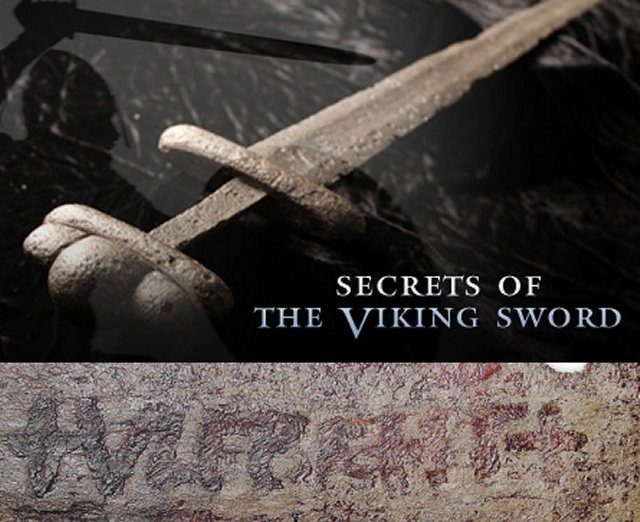Tyrfing And Gram: Two Magical Swords And Hervor’s Death In Norse Mythology
Ellen Lloyd - AncientPages.com - Norse mythology contains wonderful stories about powerful gods and goddesses, creative dwarves, ugly and funny trolls, mysterious places, and strange magical objects.
Swords played a significant role in Norse Sagas and the lives of the Vikings. To give a sword a name was nothing unusual considering that they were expensive, time-consuming to produce, and associated with a distinguished warrior. One of the most famous swords is the Ulfberht sword.
The mysterious Ulfberht sword was a very advanced weapon for thousands of years of its time. Read more
Researchers have so far identified about 100 named swords in Norse mythology. In this article, Ancient Pages will examine two magical and extraordinary swords.
Hervor And Her Magical Sword Tyrfing
In The Saga of Hervör and Heidrek, a legendary Norse saga from the 13th century containing traditions of wars between Goths and Huns from the 4th century and used as a source for Swedish medieval history, we come across the tale of shieldmaiden Hervor, a young woman who always participated in battles.
Hervor possessed a magical sword named Tyrfing. It was an extraordinary weapon invincible to any warrior who fought with it. Tyrfing was always shining brightly, just like the Sun, and every time its edge was uncovered, someone got killed. No living creature could survive even the slightest wound made by the sword.
It was commonly believed that Tyrfing was forged and cursed by the dwarves Dvalinn and Durin for King Svafrlami, one of Odin’s sons. Dwarves were well-known for their outstanding ability to produce remarkable weapons.
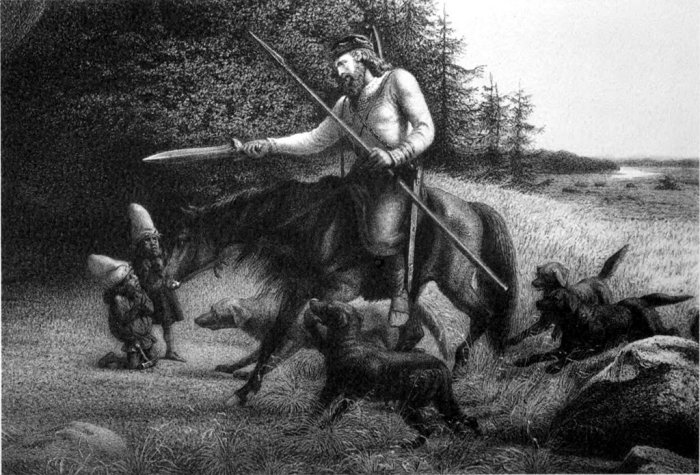 Svafrlami secures the sword Tyrfing. Image credit: Author: Lorenz Frølich (1820–1908). Source - Rydberg, Viktor. 1906. Teutonic Mythology Vol. III.Rydberg, Viktor. 1906
Svafrlami secures the sword Tyrfing. Image credit: Author: Lorenz Frølich (1820–1908). Source - Rydberg, Viktor. 1906. Teutonic Mythology Vol. III.Rydberg, Viktor. 1906
The sword never missed its target and ensured its bearer victory, naturally making it a desirable weapon.
The first owner of Tyrfing was most likely King Svafrlami. One day, he was hunting on his horse and discovered two dwarves near a large stone. He bound them by swinging his sword above them so they could not disappear. The dwarves, named Dvalinn and Durin, asked if they could buy themselves free and undertook to make a magic sword. The sword would neither break nor rust, cut through iron and stone as easily as through cloth, and always give victory.
When Svafrlami acquired the sword, he saw that it was an exquisite and beautiful weapon, and it was named Tyrfing. However, before disappearing into the rock, the dwarves cursed the weapon so that it would never be unsheathed without killing a man, would be the undoing of Svafrlami, and cause three evil deeds.
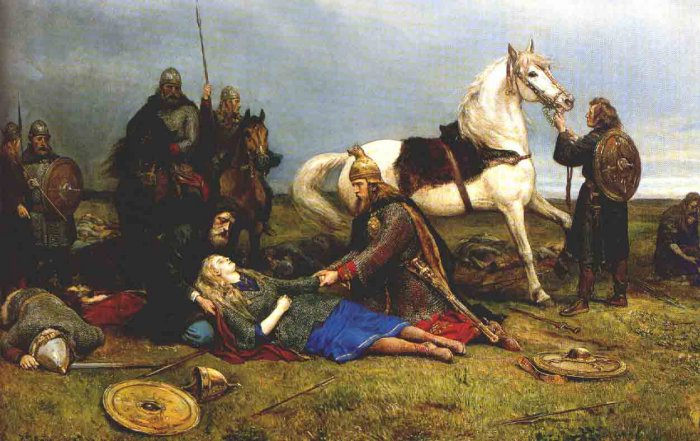 Hervor's death Peter Nicolai Arbo. Hervör was a shieldmaiden in the cycle of the magic sword Tyrfing, presented in̪ the Hervarar saga, of which parts are found in the Poetic Edda. Greatly outnumbered, she died leading the army against the first assault of the Huns in an inheritance conflict between her brothers (Hlöd and Angantýr). The men in this image may represent her foster-father (Ormar) and brother (Angantýr); but as they mourn her in Árheimar (where Ormar flees to Angantýr with a report of the invasion and defeat) exactly this scene does not occur in the saga.
Hervor's death Peter Nicolai Arbo. Hervör was a shieldmaiden in the cycle of the magic sword Tyrfing, presented in̪ the Hervarar saga, of which parts are found in the Poetic Edda. Greatly outnumbered, she died leading the army against the first assault of the Huns in an inheritance conflict between her brothers (Hlöd and Angantýr). The men in this image may represent her foster-father (Ormar) and brother (Angantýr); but as they mourn her in Árheimar (where Ormar flees to Angantýr with a report of the invasion and defeat) exactly this scene does not occur in the saga.
Apparently, Hervor took the Tyrfing from the grave of Angantyr, her father. Angantyr had inherited the sword from his father, the berserker Arngrim.
What happened to the sword when Hervor died remains a mystery.
Gram – The Magical Sword That Killed The Dragon
In the Edda, there is also a tale of another magical sword named Gram which means “enemy.”
The Gram sword is depicted on an old runestone standing on a hill just outside the Swedish city of Eskilstuna.
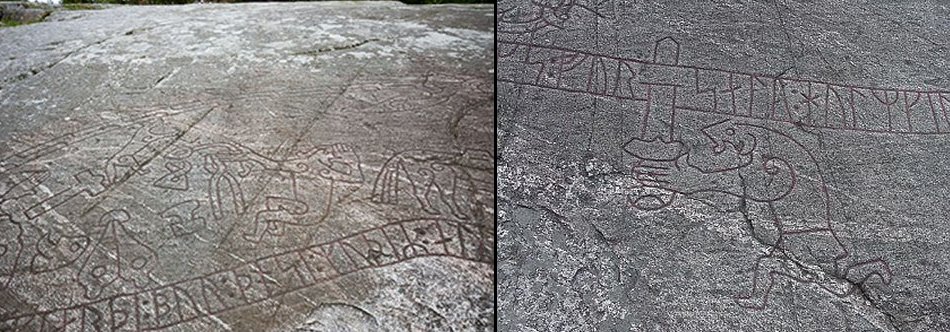 Old runestone In Sweden depicts the battle and death of the dragon.
Old runestone In Sweden depicts the battle and death of the dragon.
According to a Norse legend, a dwarf named Fafner killed his father so he could steal a huge, valuable gold treasure. Fafner was later changed into a dragon. His brother Regin was furious and sought revenge.
Together with a young boy named Sigurd, he located the hiding place of the stolen treasure. Regin forged a strong sword to kill the dragon and reclaim the treasure. He named the sword Gram and killed the dragon with it.
The legend is well-known in Scandinavia, and the event is depicted on a thousand-year-old runestone in Sweden.
Updated on March 17, 2023
Written by - Ellen Lloyd – AncientPages.com
Copyright © AncientPages.com All rights reserved. This material may not be published, broadcast, rewritten or redistributed in whole or part without the express written permission of AncientPages.com
More From Ancient Pages
-
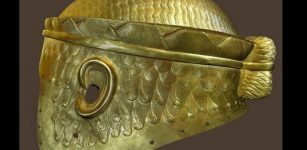 Helmet Of Meskalamdug – Sumerian King Of The First Dynasty Of Ur
Artifacts | Apr 14, 2016
Helmet Of Meskalamdug – Sumerian King Of The First Dynasty Of Ur
Artifacts | Apr 14, 2016 -
 Senegambia’s Circles: Largest Cluster Of Megalithic Structures Of Lost Civilization On Earth
Featured Stories | Jan 3, 2020
Senegambia’s Circles: Largest Cluster Of Megalithic Structures Of Lost Civilization On Earth
Featured Stories | Jan 3, 2020 -
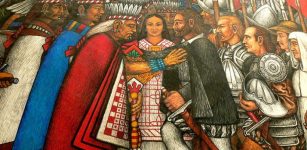 La Malinche – Greatest Traitor Or A Victim Of Hideous Circumstances?
Featured Stories | Jun 16, 2020
La Malinche – Greatest Traitor Or A Victim Of Hideous Circumstances?
Featured Stories | Jun 16, 2020 -
 First-Ever Discovery Of Roman Road Network Spanning The South West UK Made By LIDAR
Archaeology | Aug 7, 2023
First-Ever Discovery Of Roman Road Network Spanning The South West UK Made By LIDAR
Archaeology | Aug 7, 2023 -
 Ötzi The Iceman’s Stomach Bacteria And Complex History Of European Settlements
Archaeology | Jan 8, 2016
Ötzi The Iceman’s Stomach Bacteria And Complex History Of European Settlements
Archaeology | Jan 8, 2016 -
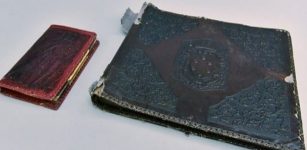 Nazi Photo Album Made Of Human Skin Found At Polish Antiques Market
History | Mar 18, 2020
Nazi Photo Album Made Of Human Skin Found At Polish Antiques Market
History | Mar 18, 2020 -
 10 Remarkable Advanced Ancient Technologies Ahead Of Their Times
Ancient Technology | Jul 23, 2019
10 Remarkable Advanced Ancient Technologies Ahead Of Their Times
Ancient Technology | Jul 23, 2019 -
 What Rights Did Viking Women Have?
Ancient History Facts | Mar 19, 2021
What Rights Did Viking Women Have?
Ancient History Facts | Mar 19, 2021 -
 Impressive Huge Ancient Lamassu Statue Unearthed In Nineveh, Iraq
Archaeology | Oct 28, 2023
Impressive Huge Ancient Lamassu Statue Unearthed In Nineveh, Iraq
Archaeology | Oct 28, 2023 -
 Tetzacualco – Mesoamerican Mini Model Of The Universe Discovered Underwater
Archaeology | Jan 4, 2018
Tetzacualco – Mesoamerican Mini Model Of The Universe Discovered Underwater
Archaeology | Jan 4, 2018 -
 10 Ancient Shipwrecks And Several Underwater Artifacts Found Around The Island Of Kasos
Archaeology | Mar 14, 2024
10 Ancient Shipwrecks And Several Underwater Artifacts Found Around The Island Of Kasos
Archaeology | Mar 14, 2024 -
 Buccaneers And Privateers Were Pirates – But What’s The Difference Between Them?
Ancient History Facts | Nov 5, 2016
Buccaneers And Privateers Were Pirates – But What’s The Difference Between Them?
Ancient History Facts | Nov 5, 2016 -
 Previously Unknown 2,000-Year-Old Celtiberian City Discovered- Has The Lost City Of Titiakos Been Found?
Archaeology | Jul 18, 2023
Previously Unknown 2,000-Year-Old Celtiberian City Discovered- Has The Lost City Of Titiakos Been Found?
Archaeology | Jul 18, 2023 -
 Underwater Robot Investigates Edo Period Decorative Tiles Off Shizuoka, Japan
Archaeology | Dec 7, 2015
Underwater Robot Investigates Edo Period Decorative Tiles Off Shizuoka, Japan
Archaeology | Dec 7, 2015 -
 Ancient Secrets Of The Aranmula Kannadi Mirror That Reflects You As You Really Look
Artifacts | Sep 10, 2021
Ancient Secrets Of The Aranmula Kannadi Mirror That Reflects You As You Really Look
Artifacts | Sep 10, 2021 -
 Mysterious Railway Car Discovered Under An Old Fortress In Antwerp, Belgium
Archaeology | Apr 12, 2024
Mysterious Railway Car Discovered Under An Old Fortress In Antwerp, Belgium
Archaeology | Apr 12, 2024 -
 Shu: Egyptian God Of Air, Symbol Of Life-Giving Breath And The One Who Separates Heaven From Earth
Egyptian Mythology | Oct 23, 2020
Shu: Egyptian God Of Air, Symbol Of Life-Giving Breath And The One Who Separates Heaven From Earth
Egyptian Mythology | Oct 23, 2020 -
 Miraculous Cauldrons Of The Ancient Celtic World
Featured Stories | Apr 17, 2024
Miraculous Cauldrons Of The Ancient Celtic World
Featured Stories | Apr 17, 2024 -
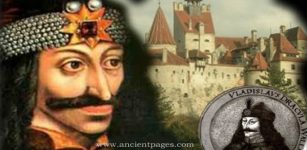 Dracula: Cruel, Ruthless And Bloodthirsty Ruler But Not A Vampire
Featured Stories | Sep 12, 2023
Dracula: Cruel, Ruthless And Bloodthirsty Ruler But Not A Vampire
Featured Stories | Sep 12, 2023 -
 On This Day In History: Sweden’s Greatest Defeat: Battle Of Kirchholm Was Fought – On Sep 27, 1605
News | Sep 27, 2016
On This Day In History: Sweden’s Greatest Defeat: Battle Of Kirchholm Was Fought – On Sep 27, 1605
News | Sep 27, 2016

